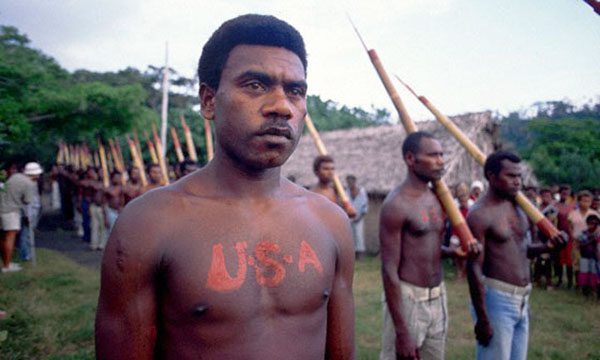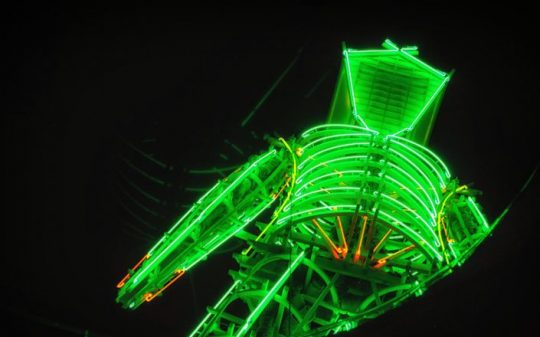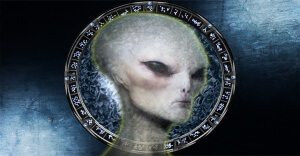What made humans believe in the existence of gods? A phenomenon known as cargo cults attempts to give an extraterrestrial explanation for the emergence of the divinity principle.
The notion of paleocontact (aliens visiting our planet in ancient times) is certainly not new. Spearheaded by Erich von Däniken in the 1960s, this idea builds on the assumption that the quasi-primitive human cultures of prehistory witnessed the sojourn of ancient astronauts, welcoming their presence as that of the gods themselves. It is probable that these ancient humans already had formed basic notions of spirits in totemic and animistic fashions and the presence of ancient spacemen only reinforced their beliefs in a higher power.
It’s not hard to envision the cultural shock suffered by an undeveloped society when exposed to technological marvels such as flying machines and advanced weaponry. At a time when mankind hadn’t even invented the wheel, witnessing the effects of technology we haven’t even developed today must have seemed nothing short of the work of all-powerful gods. Their equipment gave them supernatural powers, so the awe-stricken humans began to worship them at once. Does this seem like we’re stretching imagination too far? Because we’re not and a similar phenomenon is happening in various places throughout the globe as we speak.

The existence of cargo cults can offer an explanation as to how religion became such an important part of human life and might offer some valuable clues in support of the paleocontact hypothesis.
Cargo cults are religious movements that develop within secluded tribal societies following encounters with an external society that brought its technology with them. They are the living embodiment of Arthur C. Clarke’s Third Law, stating that any sufficiently advanced technology is indistinguishable from magic. And in case you were wondering, a cargo cult is literally based on the worship of—and with the intention of obtaining—the cargo such an advanced civilization brings with it.
The Republic of Vanuatu is a small island nation in the Southern Pacific. Before the white man stepped foot on its shores, the locals had never seen any technology above the Stone Age. In the 19th century, the islands came under a joint British-French rule and Christian missionaries were given free reign over the natives. They began enforcing their customs and policies and disrespecting them brought severe punishments.
After suffering through decades of oppression, a fellow native going by the name of John Frum (possibly a derivative of John From Jesus Christ – John the Baptist) promised them salvation from the white man’s despotism and a splinter group took refuge further inland.
History has a weird way of making waves that ripple through time and an incident they did nothing to create would cement John Frum’s identity as a saint among the people of Vanuatu. He had promised his peers vast riches if they liberated themselves from underneath the missionaries’ rule. That they did but the riches didn’t show up before the advent of the Second World War.
In the early 1940s, America was planning on building bases on islands in the Pacific and Tanna Island in the Republic of Vanuatu (still called New Hebrides at that time) seemed like a good location. The locals watched in awe as great metal birds dropped crates from the sky. The crates were full of riches the likes they had never seen before: clothing, advanced building materials, canned food, boom sticks, tools, medicine and plenty more. John Frum had been right all along and his prophecy finally came true! Thanks to the newly-acquired technology, their lives had drastically improved and this is how they came to worship the cargo brought by the white men in their shiny birds that roared like thunder.

The islanders carefully observed how the infantrymen engaged in strange rituals, like marching in formation with their rifles on their shoulders. They interpreted this peculiar (to them) liturgy as the behavior that caused more cargo to be dropped. So they began mimicking the soldiers’ customs with a religious rigor that continues to this day. Every year, on February the 15th, natives of Vanuatu celebrate John Frum Day by parading with bamboo ‘rifles’, in pants they made themselves and with USA written in red paint on their chests. John Frum is their most important saint and his day is the holiest holiday.
Things get even stranger within the cargo cults of New Guinea. Here, natives use bamboo sticks and coconuts to construct landing strips, control towers and even airplane replicas in hope that their efforts will attract the real deal—planes sent from heaven by their ancestors. The video below shows exactly what’s going on and, if the paleocontact hypothesis is correct, it paints a sad picture. It tells us we might be doing the same thing, in a more organized yet equally delusional fashion. The fool’s paradise is for everyone.
https://youtube.com/watch?v=c7RA4UnEuQ0%2520mode%3Dnormal%2520autoplay%3Dno%255D
Does this open up an intriguing parallel between our own paleocontact hypothesis or not?
As your favorite wacky-haired ancient alien theorist puts it:
“The cargo cult phenomenon illustrates the basic premise of the Classic Ancient Astronaut Theory: Thousands and thousands of years ago, technologically advanced flesh and blood extraterrestrials arrived on Earth in nuts and bolts spaceships.
Intellectually-speaking, our ancestors were not stupid (they essentially had the same brain as we have today), however, because their technological frame of reference was limited, they did not comprehend the nuts and bolts aspects behind the arrival of those flesh and blood extraterrestrials and so our ancestors misinterpreted them for being divine in nature, which, of course, the visitors were not. And thus, the “gods” were born. Out of a simple (yet major) misunderstanding.”—Giorgio A. Tsoukalos
In 2006, Smithsonian Magazine reporter Paul Raffaele conducted an interview with Chief Isaac Wan from the island of Tanna, a stern follower of the John Frum cult.
“John promised you much cargo more than 60 years ago, and none has come,” Raffaele pointed out. “So why do you keep faith with him? Why do you still believe in him?”
In all its simplicity, Chief Isaac’s reply puts things into perspective: “You Christians have been waiting 2,000 years for Jesus to return to earth,” he says, “and you haven’t given up hope.”
Photo credit: AnastasiyaPhoenix/DeviantArt










Having experienced the Holy Spirit derived from reading the Holy Bible over a period of 5 months, I know that there is a God of the Universe and HIS NAME IS JESUS THE CHRIST! THE ANTITHESIS OF THAT IS THE DEVIL AND ANYONE WHO DARES QUESTION THAT REALITY IN MY MIND REPRESENTS THE EVIL ONE, THE SERPENT, THE GODDESS SOPHIA, THE DEVIL, BEELZEBUB, BAAL, MORLOCK ET.AL!